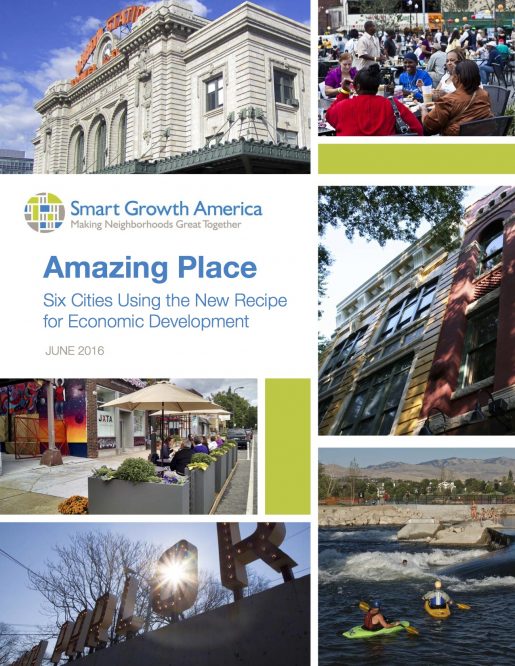
Authors
Publication Date
June 2016
Categories
Tags
Resource Type
Upcoming public events - join us!
Amazing Place
Many companies—from Fortune 500 titans to lean startups to independent manufacturers—are moving to places that offer great quality of life for their employees. As Smart Growth America detailed in our 2015 report Core Values: Why American Companies are Moving Downtown, these companies want vibrant neighborhoods with affordable housing options, restaurants, nightlife, and other amenities in walking distance, and a range of transportation options for their employees, among other things. This trend is already playing out in big cities like San Francisco and New York. It is also playing out in mid-size cities like Denver, CO and Minneapolis, MN, and small cities and towns like Greenville, SC. In each of these places, great walkable neighborhoods are helping to attract new residents, new jobs, and new investment.
This trend represents a marked shift in cities’ economic development strategy. Where cities once relied principally on subsidies or low tax rates in hopes of luring big employers, now they are doing everything they can to create great places where people and companies want to be.
As a result, the old economic development tools are no longer sufficient: tax breaks and subsidies alone do not create great places. Smart growth strategies like zoning changes, incentives for infill development, policies to make a range of housing available, street improvements, investments in transit, support for public parks and gathering spaces, and creative reuse of historic buildings are among the new, innovative ways cities are creating places where people and companies want to be.
Amazing Place: Six Cities Using the New Recipe for Economic Development looks at how six cities are using smart growth and placemaking strategies to gain a competitive edge. Our case study examples—Boise, ID; Denver, CO; Greenville, SC; Minneapolis, MN; Nashville, TN; and Pittsburgh, PA—represent a diversity of geographies, locations, population sizes, industries, and development challenges. Despite their differences, all of these cities are using smart growth development to successfully attract new companies and new residents.
Communities everywhere and of all sizes can learn from these examples. This new approach to economic development can help communities create diverse and durable local economies that last beyond the lifecycle of any one employer. As this report shows, there are many ways to create vibrant walkable neighborhoods and regional centers. Cities that want to compete in today’s economy can and should use many of these strategies to create places that are unique to their community.